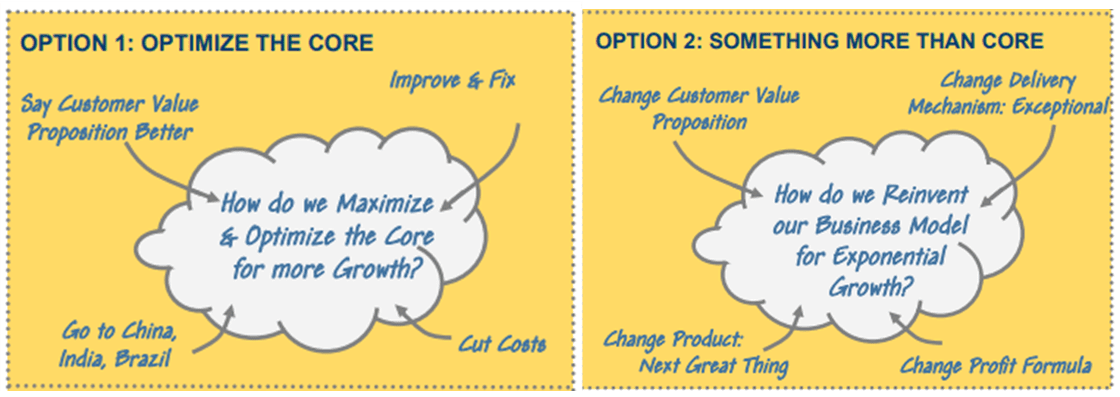
The 7 Drivers of Geometric Business Growth

The 7 Drivers of Geometric Business Growth
 by Robert Hargrove
by Robert Hargrove
 How does someone like Phil Knight take a business he started selling sneakers out of the trunk of his car and turn it into a giant company like Nike, whose iconic brand is an inspiration to every athlete?
How does someone like Phil Knight take a business he started selling sneakers out of the trunk of his car and turn it into a giant company like Nike, whose iconic brand is an inspiration to every athlete?
 How does a Tim Cook, Apple CEO, take over the company after the legendary Steve Jobs and grow the company tenfold, creating the first trillion-dollar company?
How does a Tim Cook, Apple CEO, take over the company after the legendary Steve Jobs and grow the company tenfold, creating the first trillion-dollar company?
 How did a handful of Southern entrepreneurs—Robert Woodruff, founder of Coca Cola, Sam Walton, Founder of Walmart, and S Truett Cathy, founder of Chic-fil-A, take small, hometown companies and grow them into global businesses in one lifetime?
How did a handful of Southern entrepreneurs—Robert Woodruff, founder of Coca Cola, Sam Walton, Founder of Walmart, and S Truett Cathy, founder of Chic-fil-A, take small, hometown companies and grow them into global businesses in one lifetime?
It was being fascinated and intrigued with questions like these that led to the idea of writing a CEO playbook that would help entrepreneurs step up to the CEO’s job, as well as take a small to medium enterprise (SME) and grow it geometrically.
I had spent decades coaching CEOs of the Fortune 500 to become the leaders their business needs in the process of realizing an Impossible Future and producing extraordinary and tangible business results.
I decided to call my dear friend, the legendary Jay Abraham, who had successfully coached the leaders of thousands of SMEs in hundreds of different industries, and ask him to collaborate with me. Jay was equally fascinated and intrigued by how successful CEOs take an SME and grow it exponentially, and luckily he agreed.
Both Jay and I have spent the requisite 10,000 hours in conversations with CEOs and entrepreneurs helping them reach BHAG goals, cut through problems that are like Gordian Knots, and make some of the most important decisions of their lives. We often wake up in the morning, work all day, go to bed at night, and dream about “what is the one thing we can say that will make a difference in your life.” Our hope is that this book does just this for you!
In this article, in anticipation of the book, I would like to introduce to you the 7 Drivers of Geometric Growth. Keep your eye out here as we provide you further with sneak peeks into the book.
The CEO Playbook—The 7 Drivers of Geometric Business Growth
1. PURPOSE-DRIVEN LEADERSHIP
The best CEOs built a company around an ennobling purpose that makes people come to work as if they are on a mission from God.
Apple: Change the World with the Personal Computer
Nike: Bring Inspiration and Innovation to Every Athlete in the World
Tesla: Accelerate the Shift to Sustainable Transport
2. HIRE ABERRANT GENIUSES WHO CAN PLAY AS A TEAM
The teams with the best talent usually win. When it came to hiring, Arthur Blank, Founder of Home Depot, gave instructions to his HR department in one sentence: “Get me the best in the world.” Yet, you don’t just want to hire aberrant geniuses who are loaded with talent and don’t fit the mold, nor just conformists who got an A on the test. They need to be able to play as a team. People’s ability to think and interact together has a multiplier effect on the business. Think Jony Ives and Tim Cook at Apple.
3. STRATEGY—THINK MARKETS, NOT PRODUCTS
David Valentine, founder of Sequoia Capital, a venture capital firm that bootstrapped Apple, Airbnb, and Uber, said start by asking yourself: Where are there millions of people with throbbing human needs or wants that are not being addressed that I can convert into a blueprint to a billion? Don’t start by asking yourself: How am I are going to sell the wonderful product or service that’s been sitting around in my warehouse for ten years? Jay talks about a powerful shift in paradigm: Shift from thinking in terms of a “Me” point of view to a “You” point of view.
4. LEVERAGE INNOVATION, OPTIMIZATION
If you want to compete in the future, you need to leverage a disruptive technology that has the power to make the impossible happen and be the first one into the market. Cornelius Vanderbilt, the richest man in America, was always looking for the next great thing. He disrupted the Great Age of Sail with the steamboat, then disrupted the Great Age of Steamboats with railroads. He was also a tinkerer who optimized his shipping business, steamboats, and railroads thousands of times.
5. CREATE A SCALABLE ORGANIZATION
Once your organization starts to grow in an accelerated way, you need to start thinking about building an organization (processes) that can match that growth and where all the different parts truly function as a whole. Creating a scalable organization not only takes building repeatable business processes but considerable resources. The other day I was driving down the highway and saw the first Rivian “electric truck.” The truck looked great but I wondered, how is Rivian going to build a scalable organization that can keep up with GM, Ford, Chrysler, and Mercedes?
6. LEVERAGE BOTH FINANCIAL & RELATIONAL CAPITAL
CEOs who build companies that are capable of geometric business growth know that they need capital not only to start and finance their business plan but to scale their organization. Jay Abraham has made a powerful distinction between financial capital and relational capital. Sometimes traditional financial capital just isn’t available and you have to use Relational Capital. Scott Cook of Intuit made 25 presentations before venture capitalists, and got the door slammed in his face 25 times. Finally, the finance guy in his startup said, “We need to find a rich uncle.” Cook said, “I don’t have a rich uncle.” The finance guy said, “I have two.” They went to them, laid out their business case, and started Intuit with $100,0000.
7. THE POWER OF MARKETING
I met Jay almost three decades ago when I came across some pamphlets called “Your Marketing Genius at Work.” I was trying to sell coaching and training in a crowded marketplace and just scraping by. Jay impressed me with his idea that I needed to come up with a breakthrough value proposition that would differentiate me from all the other “me too” competitors. I wrote a book called Masterful Coaching, Become the leader your business needs in the process of realizing an Impossible Future and my business started to take off.
*BONUS DRIVER
8. BE YOUR CLIENT’S MOST TRUSTED ADVISOR
When you are your client’s most trusted advisor, you are totally dedicated to causing their success. You never sell them more or less than what they really need. That’s a lot different than being a salesman who is trying to extort money from people.



 The first is to think in terms of optimizing your core business by becoming better at what you already do. Amazon invented the idea of selling stuff online, then came out with Amazon Prime which lowered shipping costs for customers.
The first is to think in terms of optimizing your core business by becoming better at what you already do. Amazon invented the idea of selling stuff online, then came out with Amazon Prime which lowered shipping costs for customers. The second is to do something more than core that really represents a whole new business model. Steve Jobs did that when he moved away from selling computers to selling devices like the iPod, iPhone, and iPad.
The second is to do something more than core that really represents a whole new business model. Steve Jobs did that when he moved away from selling computers to selling devices like the iPod, iPhone, and iPad.






